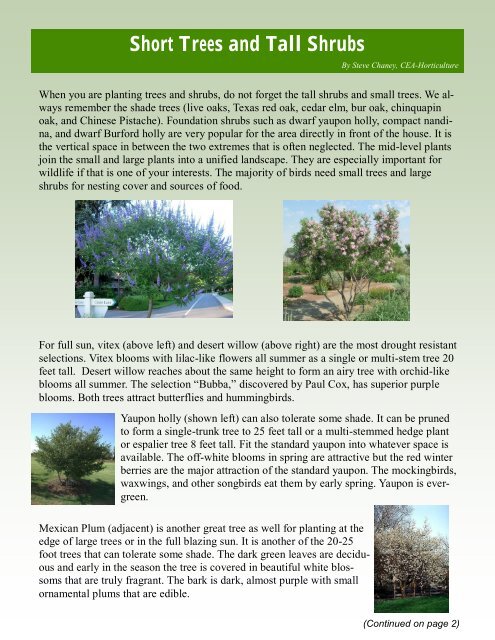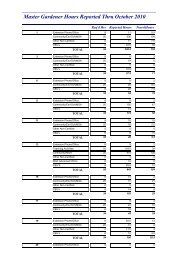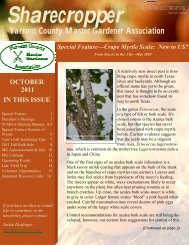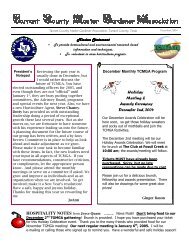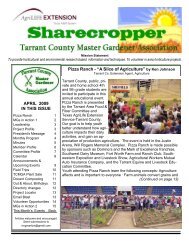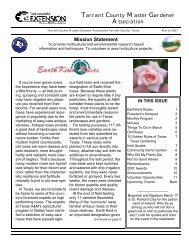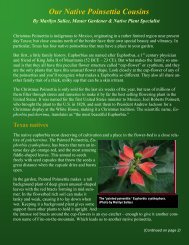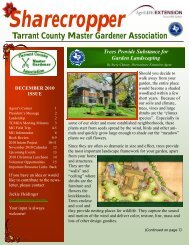You also want an ePaper? Increase the reach of your titles
YUMPU automatically turns print PDFs into web optimized ePapers that Google loves.
<strong>Short</strong> <strong>Trees</strong> <strong>and</strong> <strong>Tall</strong> <strong>Shrubs</strong><br />
By Steve Chaney, CEA-Horticulture<br />
When you are planting trees <strong>and</strong> shrubs, do not forget the tall shrubs <strong>and</strong> small trees. We always<br />
remember the shade trees (live oaks, Texas red oak, cedar elm, bur oak, chinquapin<br />
oak, <strong>and</strong> Chinese Pistache). Foundation shrubs such as dwarf yaupon holly, compact n<strong>and</strong>ina,<br />
<strong>and</strong> dwarf Burford holly are very popular for the area directly in front of the house. It is<br />
the vertical space in between the two extremes that is often neglected. The mid-level plants<br />
join the small <strong>and</strong> large plants into a unified l<strong>and</strong>scape. They are especially important for<br />
wildlife if that is one of your interests. The majority of birds need small trees <strong>and</strong> large<br />
shrubs for nesting cover <strong>and</strong> sources of food.<br />
For full sun, vitex (above left) <strong>and</strong> desert willow (above right) are the most drought resistant<br />
selections. Vitex blooms with lilac-like flowers all summer as a single or multi-stem tree 20<br />
feet tall. Desert willow reaches about the same height to form an airy tree with orchid-like<br />
blooms all summer. The selection “Bubba,” discovered by Paul Cox, has superior purple<br />
blooms. Both trees attract butterflies <strong>and</strong> hummingbirds.<br />
Yaupon holly (shown left) can also tolerate some shade. It can be pruned<br />
to form a single-trunk tree to 25 feet tall or a multi-stemmed hedge plant<br />
or espalier tree 8 feet tall. Fit the st<strong>and</strong>ard yaupon into whatever space is<br />
available. The off-white blooms in spring are attractive but the red winter<br />
berries are the major attraction of the st<strong>and</strong>ard yaupon. The mockingbirds,<br />
waxwings, <strong>and</strong> other songbirds eat them by early spring. Yaupon is evergreen.<br />
Mexican Plum (adjacent) is another great tree as well for planting at the<br />
edge of large trees or in the full blazing sun. It is another of the 20-25<br />
foot trees that can tolerate some shade. The dark green leaves are deciduous<br />
<strong>and</strong> early in the season the tree is covered in beautiful white blossoms<br />
that are truly fragrant. The bark is dark, almost purple with small<br />
ornamental plums that are edible.<br />
(Continued on page 2)
<strong>Short</strong> <strong>Trees</strong> <strong>and</strong> <strong>Tall</strong> <strong>Shrubs</strong> (cont’d)<br />
Redbud is another good tree for planting at<br />
the edge of large shade trees. It is another 25<br />
-foot tree that can tolerate some shade. The<br />
heart-shaped leaves are deciduous. In early<br />
spring, before the leaves are back, its pink<br />
blooms cover the stems. Plant the Texas, Oklahoma,<br />
or Mexican selections for best<br />
drought tolerance.<br />
There are a number of large shrubs from<br />
which to choose. Avoid the red-tipped photinia.<br />
It is becoming short-lived in the DFW<br />
metro area because of chlorosis <strong>and</strong> an untreatable<br />
fungal leaf spot.<br />
much by the deer. In some neighborhoods<br />
they also pass up pittosporum.<br />
Take a few moments as you drive through<br />
your neighborhood to observe what plants<br />
are doing well in your area. Take the time to<br />
talk to some of your local nurseries about<br />
plants that do well in your area. Visit your<br />
local Botanic Garden or Arboretum to find<br />
the plants that have tested well in your area.<br />
These steps will greatly enhance your l<strong>and</strong>scape<br />
if taken before planting, rather then<br />
after. Enjoy the Garden <strong>and</strong> enjoy life, it’s<br />
always best if you enjoy life in the garden!<br />
Hollies <strong>and</strong> n<strong>and</strong>inas are good choices. They<br />
are good xeriscape plants, are evergreen,<br />
tolerate sun or shade, <strong>and</strong> produce berries<br />
that are eaten by songbirds. The st<strong>and</strong>ard<br />
n<strong>and</strong>ina produces colorful winter foliage if it<br />
is grown in the sun. The st<strong>and</strong>ard Burford<br />
holly is probably the best of the large hollies<br />
for DFW. The n<strong>and</strong>ina reaches 7 feet tall <strong>and</strong><br />
the Burford holly reaches about 8 feet tall.<br />
I planted three types of viburnum:<br />
Spring Sweet S<strong>and</strong>ankwa<br />
Bouquet Viburnum Viburnum<br />
These viburnums generally do well in the<br />
shade. One species, rusty blackhaw, prefers<br />
full sun where it has good fall color.<br />
Of the trees <strong>and</strong> shrubs listed in this article,<br />
vitex, desert willow, yaupon holly, n<strong>and</strong>ina,<br />
<strong>and</strong> wax myrtle do not seem to be eaten


